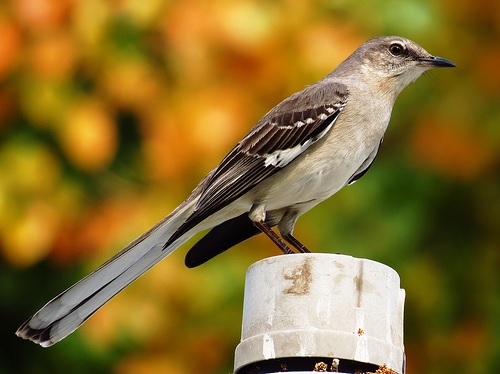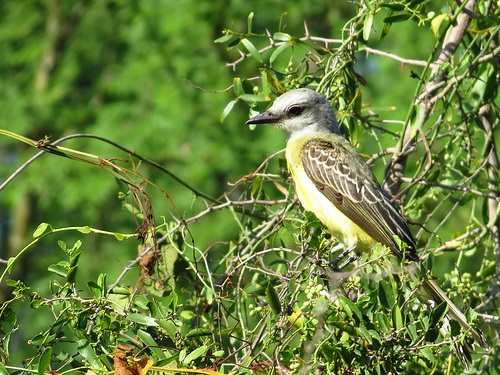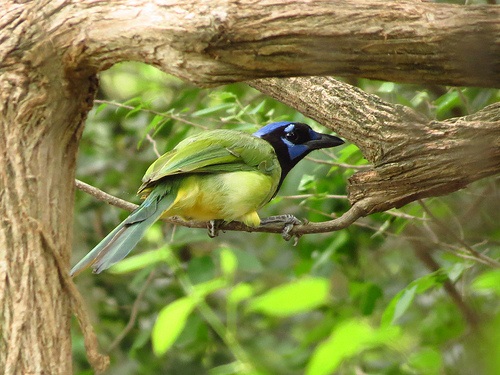The light breeze spread the fragrance of recently-opened flowers, and birdsong filled the air during yesterday morning’s bird walk. In addition to stellar views of many beautiful, year-round birds, one early migrant from up north also made an appearance!
This is the time of year when juvenile birds (young-of-the-year) are out and about. From the ever-calling Northern Mockingbirds, to the Olive Sparrows and White-winged Doves, it was a treat to see the young of these species exploring the woods. Juvenile birds of other species were seen too! One of the highlights of yesterday morning’s hike was seeing Plain Chachalaca young following their parents throughout the tree branches, trails and water features at Quinta Mazatlan. Right now there are several families of chachalaca roaming around, each with their own young; some have recently-fledged young, and some have young that are nearly fully-grown. Chachalaca love to forage on fruits throughout the trees. If you catch a sunlit glimpse of these brown, long-tailed, chicken-like birds, you may even witness the glossy olive-green sheen that shines off of their brown wings.

Plain Chachalacas are busy raising their young at Quinta Mazatlan this time of year! I wonder how much longer it will be until the little ones are taking after their parents, and begin to give those classic squawking calls.

Feather care is crucial for a bird to remain healthy. Here is a Plain Chachalaca, preening its feathers atop a snag during yesterday morning’s bird walk.

Known for their loud and raucous calls, Green Parakeets were observed surprisingly-close during yesterday morning’s bird walk. In addition to the rich array of greens, what other colors do you see on these two beautiful birds?
Northern Mockingbirds are year-round residents at Quinta Mazatlan. Juvenile Northern Mockingbirds are out and about right now, exploring the many nooks and crannies inside the nearby habitat. Male Northern Mockingbirds are known for their complex and varying songs. Some male Northern Mockingbirds have been known to imitate nearly 200 different sounds!

Juvenile Northern Mockingbird. The pink base of the bill and mottled frontside are field marks that show this is a young Northern Mockingbird. Adults would be dark-billed, and would have an evenly-pale frontside.

This female Black-and-White Warbler was one of the uncommon stars of the morning. She is arriving here quite early! Black-and-White Warblers nest well north and northeast of here. Once fall comes around, more Black-and-White Warblers will begin to establish their wintering grounds here in the valley. Keep your eyes out for new migrants as the summer progresses!
Here is the eBird list of birds observed during yesterday morning’s bird walk at Quinta Mazatlan.
Black-bellied Whistling-Duck 3
Plain Chachalaca 14 saw 4 or 5 chicks
Great Egret 1
Rock Pigeon (Feral Pigeon) 5
White-winged Dove 15
Mourning Dove 1
Inca Dove 3
Buff-bellied Hummingbird 2
Golden-fronted Woodpecker 10
Green Parakeet 7
Brown-crested Flycatcher 2
Great Kiskadee 1
Tropical Kingbird 3
Couch’s Kingbird 2
White-eyed Vireo 2
Purple Martin 2
Cave Swallow 10
Black-crested Titmouse 2
Carolina Wren 1
Clay-colored Thrush 4
Curve-billed Thrasher 6
Long-billed Thrasher 3
Northern Mockingbird 5
Olive Sparrow 3 saw one feeding Bronzed Cowbird fledgling
Bronzed Cowbird 2 one was fledgling being fed by Olive Sparrow
Orchard Oriole 4
Lesser Goldfinch 2
House Sparrow 28
Good birding!
Erik Bruhnke




